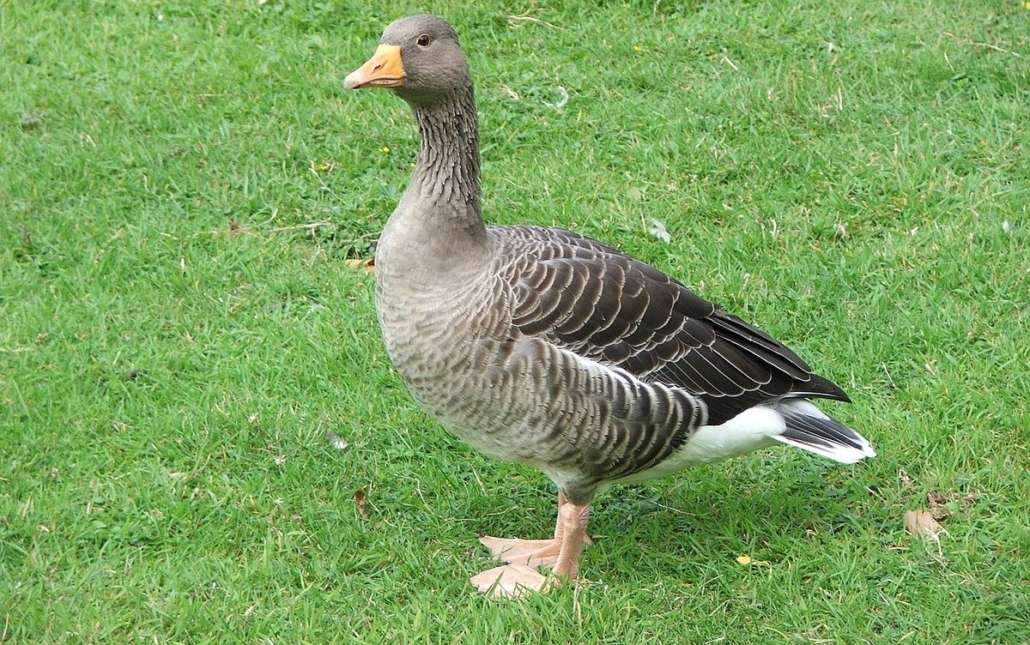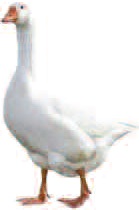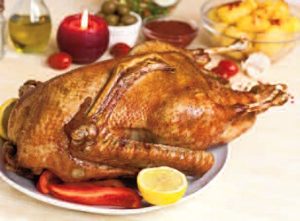SCORES & OUTDOORS: The goose and Christmas dinner

 by Roland D. Hallee
by Roland D. Hallee
Well, it’s December, and Christmas is closing in on us fast. What does that have to do with a sports and outdoors column? How about talking about one of the all time traditions of the holiday dinner – the Christmas goose. After all, even Ebenezer Scrooge, of the 1843 novella, A Christmas Carol, written by Charles Dickens, prompted by the Ghost of Christmas Present, observed the Cratchit family enjoying a goose for Christmas dinner.
The once common farm bird, the goose has a rich legacy of multi-purpose value. Geese possess down feathers, dark flavorful meat, and rich high-temperature cooking fat.
As natural foragers, geese much prefer to graze than feed on grain alone, and need the freedom to roam in search of tender grasses. Their tendency to grazing has made them difficult to be produced under farm conditions, like the turkey.
According to Frank Reese, “In the old days you’d never harvest a goose until after you had freezing weather. The old people really felt that the cold weather allowed the goose to put down that important layer of fat that was needed to make it taste like it was supposed to.”

Goose, before Christmas dinner.
I once attended a wild game dinner with some friends. As hunters and fishermen, we would gather once a year and share our bounty from the previous season. That was the first time I had tasted goose, which had been harvested in New Jersey. I found the meat to be tender, a little greasy, but very pleasant to the palette.
Geese are a waterfowl. The word goose is a direct descendent of the German word gos, with the plural ges and gandres, becoming the modern English words of goose, geese, gander and gosling, respectively.
Actually, goose is the name given to the female of the species. The males are called ganders. Interestingly, a group of geese on land or in water is called a gaggle, while in flight, it is known as a skein.
Fossils of true geese in North America seem to indicate the different species of geese have been around since about 10 million years ago.
Geese are monogamous, living in permanent pairs throughout the year; however, unlike most other permanently monogamous animals, they are territorial only during the short nesting season. Paired geese are more dominant and feed more, two factors that result in more young.
However, farmyard ganders have been known to have a harem of three or four females. They are extremely dedicated partners and will actually mourn the loss of a mate.

And the Goose just before Christmas dinner.
Geese are herbivores, and the bumps in their beaks are used for cutting through grass stems. Since the inside of the beak and the tongue are serrated, they are often mistaken as fangs.
The goose is also the subject of many well-known sayings in American culture:
- What’s sauce for the goose is sauce for the gander;
- Your goose is cooked;
- Killing the goose that lays the golden eggs;
- A wild goose chase.
The Egyptians domesticated the goose more than 3,000 years ago. Properly cared for, geese can live to be as old as 20 years.
In Victorian England, the goose was the chimney sweep’s favorite tool. The goose was lowered down the chimney to collect the built up coal, and would come out the other end blackened with soot.
Another historical fact about geese: their feathers were used in some of the first golf balls, being created by hand, making them extremely expensive.
How do you cook a goose (no pun intended)? Very carefully.
As a casual dabbler in the culinary arts, I suggest this: Let it stand at room temperature for 30 minutes. Generously salt both the inside and out and fill the cavity with garlic, thyme and sage. Prick small holes over the skin, being careful not to pierce the meat. This allows the fat a chance to render out during roasting. Cook low and slow, preferably at 325°F.
Having a tendency to be a bit dry, the meat should be served medium-rare. If you’re worried about the dark meat, to ensure it has had time to become tender, remove the breast part way through roasting.
Now, trying to find a goose at the local grocery store can result in a “wild goose chase.”
Roland’s trivia question of the week:
The New England Patriots are 6-5 in Super Bowl appearances. Name the teams to which they lost.
Responsible journalism is hard work!
It is also expensive!
If you enjoy reading The Town Line and the good news we bring you each week, would you consider a donation to help us continue the work we’re doing?
The Town Line is a 501(c)(3) nonprofit private foundation, and all donations are tax deductible under the Internal Revenue Service code.
To help, please visit our online donation page or mail a check payable to The Town Line, PO Box 89, South China, ME 04358. Your contribution is appreciated!


Leave a Reply
Want to join the discussion?Feel free to contribute!